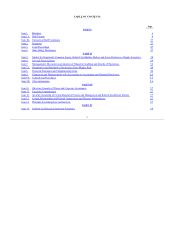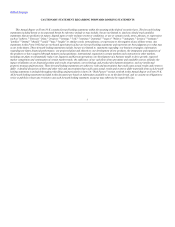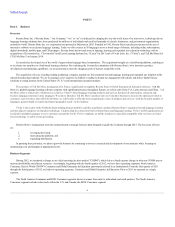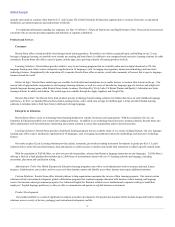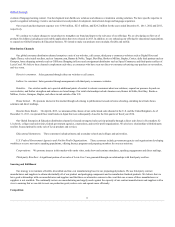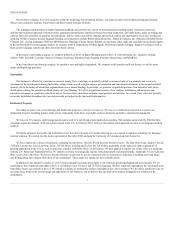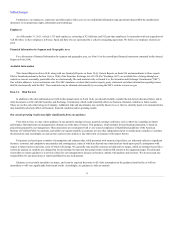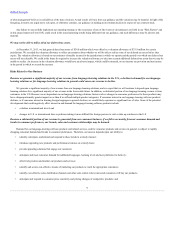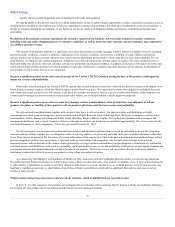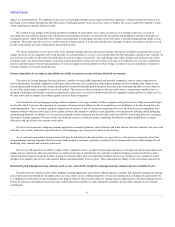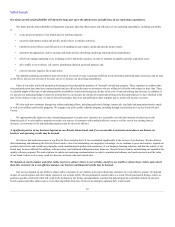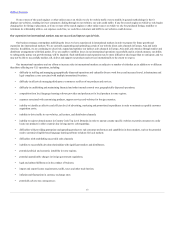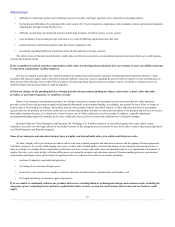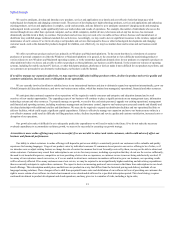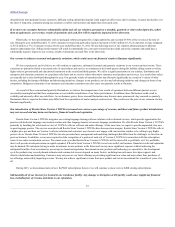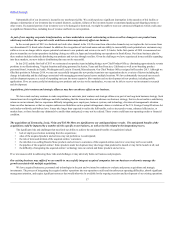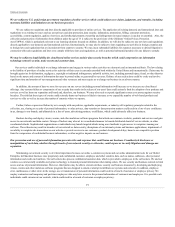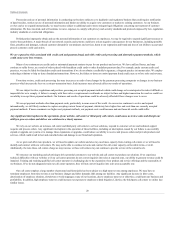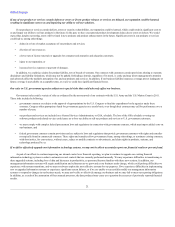Rosetta Stone 2013 Annual Report Download - page 12
Download and view the complete annual report
Please find page 12 of the 2013 Rosetta Stone annual report below. You can navigate through the pages in the report by either clicking on the pages listed below, or by using the keyword search tool below to find specific information within the annual report.
Table of Contents
subject to certain limitations. We establish revenue reserves for packaged product returns based on historical experience, estimated channel inventory levels,
the timing of new product introductions and other factors. If packaged product returns exceed our reserve estimates, the excess would offset reported revenue,
which could hurt our reported financial results.
We continue to test changes to the pricing and delivery methods of our products. If we reduce our prices or our method of delivery as a result of
successful tests in an effort to increase sales volume and overall market penetration, we may provide our retailers and distributors with price protection on
existing inventories, which would allow these retailers and distributors a credit against amounts owed with respect to unsold packaged product under certain
conditions. These price protection reserves could be material in future periods. It is uncertain whether these strategies will prove successful or whether we will
be able to develop the necessary infrastructure and business models.
The intense competition we face in the sales of our language learning solutions and general economic and business conditions can put pressure on us to
change our prices. If our competitors offer deep discounts on certain products or services or develop products that the marketplace considers more valuable, we
may need to lower prices or offer other favorable terms in order to compete successfully. Any such changes may reduce margins and could adversely affect
operating results. Any broad-based change to our prices and pricing policies could cause our revenues to decline or be delayed as our sales force implements
and our customers adjust to the new pricing policies. If we do not adapt our pricing models to reflect changes in customer use of our products or changes in
customer demand, our revenues could decrease.
Intense competition in our industry may hinder our ability to generate revenue and may diminish our margins.
The market for foreign language-learning solutions is rapidly evolving, highly fragmented and intensely competitive, and we expect competition to
persist and intensify. Increased competition could cause reduced revenue, price reductions, reduced gross margins and loss of market share. Many of our
current and potential competitors have longer operating histories and substantially greater financial, technical, sales, marketing and other resources than we
do, as well as greater name recognition in select local markets. The resources of these competitors also may enable them to respond more rapidly to new or
emerging technologies and changes in customer requirements, reduce prices to win new customers and offer free language-learning software or online services.
We may not be able to compete successfully against current or future competitors.
As the market for foreign language-learning solutions continues to develop, a number of other companies with greater resources than ours could attempt
to enter the market or increase their presence by acquiring or forming strategic alliances with our competitors or our distributors or by introducing their own
competing products. These companies and their products may be superior to any of our current competition. We have also seen increased competition from
imitation products which are lower priced, lower quality products that attempt to capitalize on the popularity of our products by utilizing similar packaging
and marketing materials. In addition, we see increased competition from community practice providers which provide low priced entry points for consumers
interested in learning languages. We may not have the financial resources, technical expertise, marketing, distribution or support capabilities to compete
effectively with any of these new entrants to the market.
We have seen an increase of language-learning applications on mobile platforms, such as iPhones and iPads, that are offered at extremely low prices and,
while they are currently limited in scope and ability to teach languages, they may present a threat as they develop.
As we continue to expand into foreign markets both directly and indirectly through resellers, we expect that we will experience competition from local
foreign language-learning companies that have strong brand recognition and more experience in selling to local consumers and a better understanding of local
marketing, sales channels and consumer preferences.
Our success will depend on our ability to adapt to these competitive forces, to adapt to technological advances, to develop more advanced products more
rapidly and less expensively than our competitors, to continue to develop an international sales network, to adapt to changing consumer preferences and to
educate potential customers about the benefits of using our solutions rather than our competitors' products and services. Existing or new competitors could
introduce new products and services with superior features and functionality at lower prices. This could impair our ability to sell our products and services.
Demand for paid language-learning solutions such as ours could decline if effective language-learning solutions become available for free.
Presently there are a number of free online language-learning applications and websites offering limited vocabulary lists, grammar explanations and tips,
and crowdsourced text translations. In addition, there are some online services offering limited free lessons and learning tools, including one sponsored by the
U.S. Department of Education to help immigrants learn English. Many of these websites offer free language practice opportunities with other language learners.
If these free products and applications become more sophisticated and competitive or gain widespread acceptance by the public, demand for our solutions
could decline.
11



